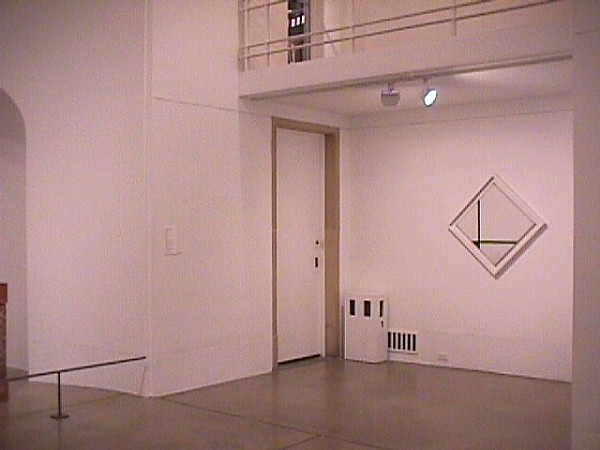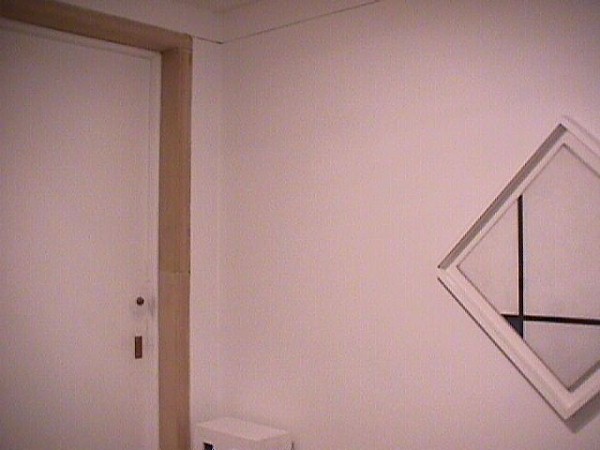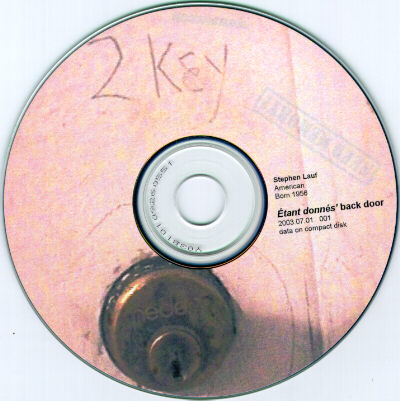2002.11.30 13:36
Re: positioning Étant donnés [wavelengths]
I went to the Philadelphia Museum of Art (PMA) Library two Tuesdays ago, but alas that is not the place to conduct research regarding Duchamp's involvement vis-ŕ-vis the Arensberg collection and its ultimate residing within the PMA. The Museum Archives is the place to do the research, but it just so happens that the Museum Archives have just begun the large project of organizing all the Arensberg/Duchamp archived material. [Do some people at the PMA read the Duchamp online bulletin board? I know that at last d'Harnoncourt reads Tout Fait.] Nonetheless, I did find out that the rooms that now accommodate Étant donnés and the visitors/viewers quarters were storage rooms before--at least that's what an older librarian(?) at the PMA remembers.
At this point, for me at least, it seems reasonable to believe that Duchamp was well aware of the (future Étant donnés) space at the PMA while he was secretly working on Étant donnés in NY, and that quite possibly this knowledge made it easier to work "underground" since what he was doing was already going to be a museum piece.
If Étant donnés is Duchamp's great underground work, is his activity at the PMA, especially his organizing of his own works within the museum, Duchamp's great above-ground work of the same period?
The original printing of the PMA Bulletin of 1969 that introduced Étant donnés contains a forward where "Dr. Evan Turner described the long relationship between Marcel Duchamp and the PMA..." [I have yet to read this text.]
Chapter 18 of Triumph on Fairmount: Fiske Kimball and The Philadelphia Museum of Art (1959) is entitled "The Arensbergs" and comprises a series of letters by Kimball that describe each of his visits with the Arensbergs in LA.
Entertaining anecdote from Triumph on Fairmount, p. 299:
The next day, Ingersoll was in the Arensberg galleries when Fiske came in with Perry Rathbone, the new director of the Boston Museum.
This is the 'big glass,'" he said, pointing to a large shattered pane of glass decorated with oil paint and lead wire in abstract patterns, which was mounted on a stand in front of the window looking out on the courtyard. "Duchamp called it The Bride Stripped Bare By Her Bachelors, Even." He laughed and went on in a loud voice to make several vulgar remarks.
"Fiske, you cannot talk like that here. Remember you are in a public place." "I'll talk as I please," said Fiske. "You aren't my boss any more."
Rathbone did not know what to make of this passage, for it was not until the following Tuesday, January 25, 1955 that Fiske's resignation was published.
[Museum Studies 6.2: on any given January 19 go stand in front of The Bride Stripped Bare By Her Bachelors, Even and laugh and make several vulgar remarks.]
2003.01.22 13:14
Re: Favorite Artist?
Furthermore, while everyone thought Duchamp had given up art for chess playing, he was actually being an "underground artist" (Duchamp's own term). And even further, during the early 1950s, Duchamp was arranging the Arensberg collection at the Philadelphia Museum of Art, a collection that includes the largest collection of Duchamp works anywhere. Thus Duchamp literally arranged the bulk of his own work within a major museum, including the covert Étant donnés.
Duchamp is both literally and figuratively a very good aperture through which to view 20th century art.
Arranging one's own art work within a museum, what a virtually interesting idea. Perhaps even worth reenacting.
2003.01.22 15:10
Re: Favorite Artist?
Be sure to read, if you haven't already done so, the text Duchamp prepared and read for the panel discussion "Where do we go from Here? at Philadelphia, 20 March 1961. This text is within the "Ephemerides..." of Hulten et al, Marcel Duchamp: Work and Life, 1993. It is at the end of this speech/text that Duchamp states, "The great artist of tomorrow will go underground."
Given that we now know that Duchamp was secretly working on Étant donnés at that time, it seems only natural to assume that Duchamp was indeed clandestinely referring to himself. Not only was Duchamp good at reenacting, he got pretty good at preenacting as well.
Duchamp, an underground artist predicting the future greatness of himself. How artistic can you get[?]!
| |
2003.03.24 11:22
cracks in a niche with restricted entrance
Étant Donnés' back door shares a niche with two Mondrians at the Philadelphia Museum of Art.

Composition with Blue (1926) hangs on the wall next to Étant Donnés' back door,

and Composition with White and Red (1936) hangs on the wall across from Étant Donnés' back door,

and it takes "2 KEY" to open Étant Donnés' back door.

| |
2003.03.24 18:45
Re: Pat Lipsky at Eizabeth Harris
thingsthatgo,
"2 KEY" just happens to be inscribed above the lock on the door that leads into the space of Duchamp's Étant Donnés. This inscription has been there since (at least) March 2001, as far as I know. I'm guessing there is a special way to open that door. For me personally, I just like calling attention to the door because it is the real means of physically accessing Étant Donnés other than looking through the peepholes of Étant Donnés's front door. The "2 KEY" adds a chance coincidence to the 'aura' of the work, if you will. Of course, in the future the door will be repainted and "2 KEY" will be 'history'.
kiss my abstract did the same thing I did by calling attention to the "sculpture" next to the door, that is, finding a chance "artwork."
Yeah, it's just a little game.
I'm guessing Duchance finds humor in the Mondrian cracks vis-a-vis the Duchamp cracks (of the Large Glass in particular, which Duchamp retrospectively referred to as a(nother) readymade).

Stephen Lauf, Étant donnés' back door (Philadelphia: www.museumpeace.com, 2003.07.01), $50.00.
An artistic investigation of Marcel Duchamp's work in situ, and hence a manifestation of the work's influence. A PC formatted compact disk documentation, 295 html pages, 665 images. Each CD is signed and numbered from an edition of 100.
Artist's intention: "I hope that at some points this work cracks you up."
|